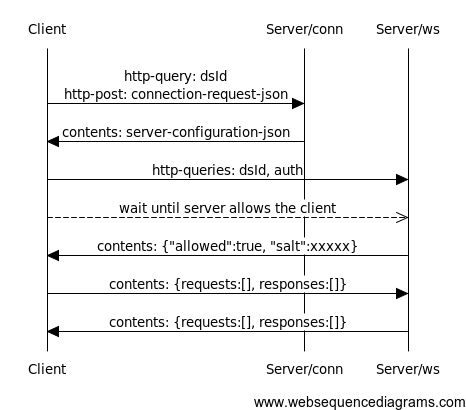-
Notifications
You must be signed in to change notification settings - Fork 12
Protocol Communication
Security is at the core of DSA. Inter-node connections in DSA are typically initiated by the Responder to the Requester. This achieves deployment flexibility as an added benefit allows for nodes on a LAN to establish secure, full-duplex connections to nodes on a WAN.
There are 3 inter-node connection types in DSA:
- Requester - Requester is able to browse and interact with the model of a Responder
- Responder - Responder is able to expose its model structure, stream model updates and receive commands from Requesters
- Requester + Responder - A DSBroker implements this pattern in an effort to route requests and responses between connected nodes
A Test Case of the handshake algorithm
The Handshake is based on ECDH with the NIST recommended curve P-256, also known as secp256r1.
All Base64 encoded strings used in DSLink handshake are url and filename safe Base64 alphabet rfc-4648 with no padding
The request uses an HTTP POST method to perform the request. A json request data is posted to the server's connection end point:
{
"publicKey": "BEACGownMzthVjNFT7Ry-RPX395kPSoUqhQ_H_vz0dZzs5RYoVJKA16XZhdYd__ksJP0DOlwQXAvoDjSMWAhkg4",
"isRequester": true,
"isResponder": true,
"linkData": {},
"version": "1.0.4"
}Query Parameters:
- dsId
- A unique string of 43-128 characters, the last 43 characters are url safe Base64 encoded SHA256 hash of the public-key binary
- example: "link-dataflow-s-R9RKdvC2VNkfRwpNDMMpmT_YWVbhPLfbIc-7g4cpc"
JSON parameters:
- publicKey
- Base64 of a ECDH public key ECPoint encoded in X9.63 (uncompressed)
- isRequester
- Indicates if the client is a requester
- isResponder
- Indicates if the client is a responder
- linkData
- Extra data a DSLink can attach for the requester to utilize
- version
- version of DSA protocol
This is an example configuration of a DSA node.
{
"dsId": "broker-dsa-FEuG-dsvoy3Mfh-DY4ZLqxWdcjA9mky2MyCd0DmqTMw",
"publicKey": "BG4OYopcM2q09amKRKsc8N99ns5dybnBYG4Fi8bQVf6fKjyT_KRlPMJCs-3zvnSbBCXzS5fZfi88JuiLYwJY0gc",
"wsUri": "/ws",
"httpUri": "/http",
"tempKey": "BARngwlfjwD7goZHCh_4iWsP0e3JszsvOtovn1UyPnqZLlSOyoUH1v_Lop0oUFClpVhlzsWAAqur6S8apZaBe4I",
"salt": "0x205",
"path": "/downstream/link",
"version": "1.0.4",
"updateInterval": 200
}When client connect to server's connection end point, server should return its configuration JSON in the http response body
- dsId
- dsId of the server
- publicKey
- Base64 of a ECDH public key ECPoint encoded in X9.63 (uncompressed)
- wsUri
- An endpoint for web socket connection
- Absolute URI to a different host or port is not allowed
- Requires a query parameter of "auth"
- SHA256 (UTF8Bytes (salt) + SharedSecret) ("+" here means concatenating of byte buffer)
- The salt is already provided within the JSON response
- httpUri
- An endpoint for http connection
- Absolute URI to a different host or port is not allowed
- See HTTP Queries
- tempKey
- a one time public key for the ECDH
- Base64 of a ECDH public key ECPoint encoded in X9.63 (uncompressed)
- salt
- A salt string to protect connection from replay attack on websocket connection
- Server should make sure that the salt is never reused unless connection is reset and nonce is regenerated
- path
- The full path where the DSLink is located on the broker
- updateInterval
- Only affects the responder
- When specified, a responder shouldn't send stream updates to server more often than the minimum interval in milliseconds, value subscriptions in the responder should be cached.
- If a value subscription update is already cached then it should update the cache with the new value to prevent useless updates or updating an incorrect value.
- This value only affects the time between 2 updates of same stream.
- If the responder does not respect the interval the requestor may close the connection due to flooding.

both websocket client and server need to make sure a message is sent to other side at least once every 60 seconds, (because of network latency can cause message delay on other side, 30 ~ 45 seconds is suggested value for a minimal interval)
if no message is received in 60 seconds, websocket should be considered disconnected and a re-connection is needed
The client must send the following url parameters:
- dsId
- dsId of the client
- auth
- Authentication string encoded in Base64 to prove client is a valid owner of the dsId and publicKey
- SHA256 (UTF8Bytes (salt) + SharedSecret ) ("+" here means concatenating of byte buffer)
- SharedSecret is the result of a standard ECDH with client's private key and server's one time public key: tempKey
- salt
- The server creates a new salt every time for the client to hash the decrypted nonce bytes.
- This is used for a "auth" token in a second websocket connection after the first one get disconnected
- 1.0.1
- support ping message, websocket should be closed if not receving any message from other side for more than 1 minute
- 1.0.2
- support binary channel
- 1.0.3
- trust local dslink connected from 127.0.0.1, server don't send tempKey and salt, and don't do auth check
- 1.0.4
- support ack
Protocol
◌ Design
◌ Initializing Connection
◌ Node API
◌ Methods
◌ Broker
◌ Broker Discovery
◌ Configs
◌ Value Types
◌ Tokens
◌ Quality of Service
DSLink Manager
◌ dslink.json
◌ Startup Command
SDK Development
◌ Implementation Guide
DSA Server
◌ Installation
◌ Update Server
◌ Server Configuration
◌ CLI Tools
◌ DSA Permission Basics
◌ DSA Permission Model
◌ Permission List for the Root
◌ Authentication
◌ OpenID Connect
◌ Password Hasher
◌ DGLux Server SSL (HTTPS)
◌ Docker
◌ Audit
◌ Data Node
◌ Install NGINX with DSA Server
◌ Configure Ubuntu Linux to auto start DSA server
◌ Troubleshooting